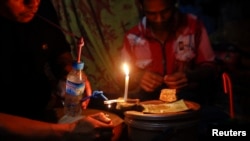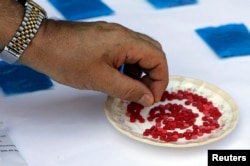Drug seizures reported across Southeast Asia indicate this year will be another record high for methamphetamine production in Myanmar. The focus is usually on government efforts to stem the trade, but beyond the headlines, meth use also has a tragic personal side.
For 25-year-old Jan Htoi La, addiction started when he used ‘yaba’ pills to stay awake while he worked long hours in one of Myanmar’s jade mines.
“At first I snorted black heroin, later, I started using yaba to be active when I was digging,” explains Jan Htoi La. “It (Yaba) is a kind of refreshment for jade traders business talks and a kind of medicine to work hard all day and all night.”
Crazy drug
Yaba pills may look like harmless, red candies, but they're made of a toxic mix of low grade methamphetamine and caffeine. It’s known in Thai as “the crazy drug” and costs no more than $3 to $4 per pill.
Jan Htoi La was one of the lucky ones who realized he was addicted and needed help. There were few choices for clinical support in the jade mining area of Hpakant, but he eventually found a makeshift rehabilitation center, supported by a Kachin Baptist church.
Now, he volunteers at the clinic to help other addicts become clean.
Just a few hours drive from Jan Htoi La’s clinic, many of the chemicals used to make meth enter Myanmar, crossing the border from China.
“High volumes of chemicals continue to flow through the region into areas with significant drug production, especially the upper Mekong area and Shan State, with either no seizures or modest amounts being seized in bordering countries relative to the volume of drugs being produced,” said Jeremy Douglas, the Regional Representative for Southeast Asia for the U.N. Office on Drugs and Crime (UNODC).
Soaring seizures
In the first three months of this year, 9 million meth pills were seized in Myanmar. Malaysia made its largest-ever seizure in May, 1.2 tons of crystal methamphetamine that were produced in Myanmar.
Myanmar is the second largest producer of opium in the world and is now the largest producer of methamphetamine, estimates UNODC.
“We are seeing large numbers of seizures [of methamphetamine] here and as far as Australia and it is overtaking everything in this country,” said Troels Vester, UNODC Myanmar country officer.
Asia-Pacific counter-narcotics police and country representatives met in Myanmar’s capital Naypyidaw last week to develop a new strategy to tackle the drug problem.
For the first time the focus was on chemicals entering Myanmar.
Myanmar is wedged between China and India - two of the largest producers of the chemicals used to make meth - and their support for a new strategy was welcomed by Myanmar authorities.
“Frankly the key will be a comprehensive regional solution involving source, transit and producing countries, given the information shared indicated trafficking routes are extensive and shift easily,” Douglas told VOA after the conference ended.
Practical training of border guards is expected to be stepped up and more human resources are due to be allocated.
Although China and India committed to participate in a regional strategy, Douglas emphasized that tackling transnational crime groups is also a major challenge, “organized crime are using new methods, and they are diversifying the synthetic drugs they produce.”
Drug gangs are expanding to supply synthetic opioids like fentanyl and ketamine in the Golden Triangle.
Yaba crisis
Asia’s new stimulant drug of choice, yaba, is causing a health crisis in Myanmar as people are taking drugs at a younger age.
“It has come to the point where from a prevention effort within universities means that there’s no point to start there anymore, at that point people have to get offered treatment, so prevention has to start much earlier at school,” said Vester, who spoke at the conference in Naypyidaw.
Jan Htoi La said the self-help drug rehab camps from Yangon to rural areas close to conflict zones, such as towns in Northern Shan and Kachin State, urgently need financial and technical support from the government.
Youth worker Ko Sai Aung Kham agreed that health professionals in Myanmar can barely treat opium users and now that problem has been compounded with the rise in methamphetamine drugs. “Many health staff think you treat it the same as heroin and give codeine, others just turn them away,” he said.
The government says it is working with the UNODC to discuss the problem as an issue for security and safety for the country, not just supply reduction.
For Jan Htoi La, he hopes the government will deliver urgent support for the many drug addicts in his homeland: “I think the government should help rehabilitation centers, now there is already not enough room for more addicts, we have to take it seriously.”







